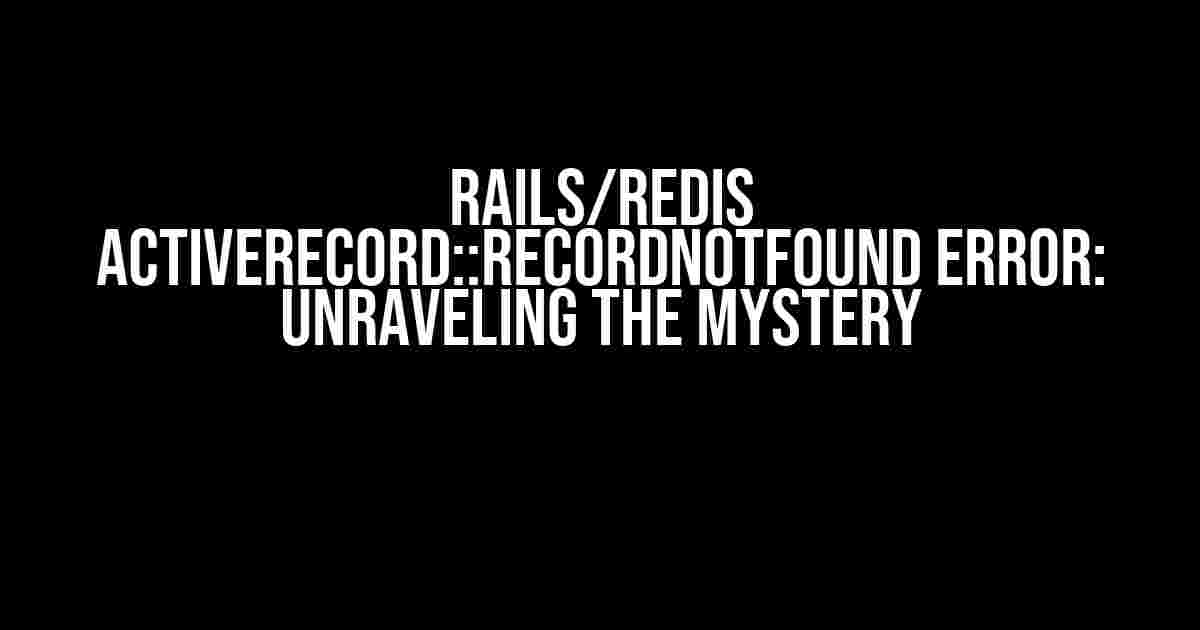Are you tired of seeing that pesky ActiveRecord::RecordNotFound error, even when you’re certain the record exists? You’re not alone! In this article, we’ll delve into the world of Rails and Redis, exploring the causes and solutions to this frustrating issue. Buckle up, and let’s get started!
What is ActiveRecord::RecordNotFound?
Before we dive into the nuances of this error, let’s understand what it is. ActiveRecord::RecordNotFound is a Rails exception that occurs when your application can’t find a record in the database that matches your query. This can happen when you’re trying to retrieve a specific record, update, or delete it.
# Example of a RecordNotFound error User.find(1) # raises ActiveRecord::RecordNotFound if user with id 1 doesn't exist
Rails and Redis: A Match Made in Heaven?
Rails and Redis are a powerful combination, offering a robust and scalable solution for your web application. Redis, an in-memory data store, serves as a caching layer, reducing the load on your database and improving performance. However, this marriage of convenience can sometimes lead to unexpected errors, like our beloved ActiveRecord::RecordNotFound.
Causes of ActiveRecord::RecordNotFound with Rails and Redis
So, why does this error occur, even when the record clearly exists? Let’s explore some common causes:
-
Stale Cache
When you update or create a record, Redis might not be notified immediately. This can lead to a stale cache, causing your application to retrieve outdated data. If the record exists in the database but not in Redis, you’ll get the RecordNotFound error.
-
Missing Indexes
If your database lacks proper indexing, queries can take a long time to execute. This might lead to a situation where Redis returns an empty result set, even if the record exists.
-
Redis Configuration
Incorrect Redis configuration or TTL (time to live) settings can cause records to expire prematurely, leading to a RecordNotFound error.
-
Network Issues
Intermittent network connectivity problems between your Rails application and Redis can result in a loss of data, causing the error.
-
Data Inconsistencies
Data corruption or inconsistencies can occur due to concurrent updates, leading to a situation where Redis and the database are out of sync.
Debugging and Troubleshooting
Before we dive into solutions, let’s cover some essential debugging and troubleshooting techniques:
-
Verify Record Existence
Use the Rails console to verify the record’s existence in the database:
rails c
User.find(1) # if the record exists, it will be returned
-
Check Redis Cache
Use the Redis CLI to inspect the cache:
redis-cli
keys *users:1* # check if the key exists in Redis
-
Examine Query Logs
Inspect the query logs to identify any issues with your queries:
rails db:console
ActiveRecord::Base.logger.level = :debug
User.find(1) # examine the query output
Solutions to ActiveRecord::RecordNotFound with Rails and Redis
Now that we’ve explored the causes and debugging techniques, let’s tackle the solutions:
| Cause | Solution |
|---|---|
| Stale Cache |
Implement cache invalidation using Rails’ caching mechanisms, such as |
| Missing Indexes |
Add missing indexes to your database tables using Rails’ migration mechanism: |
| Redis Configuration |
Review and adjust your Redis configuration, ensuring proper TTL settings and cache expiration. Example Redis configuration: |
| Network Issues |
Implement retry mechanisms using gems like |
| Data Inconsistencies |
Implement data consistency checks using Rails' built-in mechanisms, such as |
Conclusion
The ActiveRecord::RecordNotFound error, even when the record clearly exists, can be a frustrating experience. However, by understanding the causes and implementing the solutions outlined in this article, you'll be well on your way to resolving this issue. Remember to debug and troubleshoot carefully, and don't hesitate to reach out if you need further guidance.
Happy coding, and may your Rails and Redis applications run smoothly!
Frequently Asked Question
Stuck with the Rails/Redis ActiveRecord::RecordNotFound error even when the record clearly exists? Don't worry, you're not alone! Here are some frequently asked questions to help you troubleshoot the issue.
Why am I getting a RecordNotFound error when the record is clearly in the database?
One possible reason is that Redis is caching an outdated version of the record. Try restarting your Redis server or running `Rails.cache.clear` to clear the cache. This should force Rails to retrieve the latest record from the database.
I'm using a named scope to filter records, could that be causing the issue?
Yes, named scopes can sometimes cause issues with caching. Try rewriting your scope to use a lambda function, which will force the scope to be re-evaluated on each request. For example, change `scope :active, where(active: true)` to `scope :active, -> { where(active: true) }`.
What if I'm using a third-party gem that interacts with Redis?
Some gems, like Resque or Sidekiq, use Redis for job processing. If you're using one of these gems, try checking the gem's documentation to see if it provides any cache-clearing methods. You may need to clear the gem's cache separately from the Rails cache.
Could this be related to a transactional issue?
Yes, transactional issues can sometimes cause RecordNotFound errors. Make sure you're not rolling back a transaction in a `rescue` block, as this can leave the record in a inconsistent state. Instead, use `rescue` to catch specific exceptions and handle them gracefully.
What if none of these solutions work?
If you've tried all of the above solutions and the issue persists, it may be worth digging deeper into your application's codebase to identify the root cause. Try using Rails' built-in debugging tools, like `Rails.logger` or `pry`, to inspect the query being executed and the data being returned from Redis.

